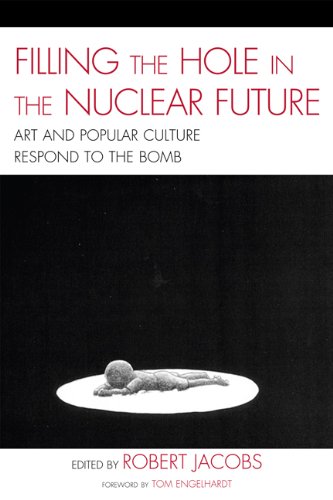
Edited by Robert Jacobs (Lexington Books, 2010)
Art and popular culture have played an essential role interpreting nuclear issues to the public and investigating the implications of nuclear weapons to the future of human civilization. While political and social forces often seemed paralyzed in thinking beyond the dilemma posed by this apocalyptic technology, art and popular culture were uniquely suited to grapple with the implications of the bomb and the disruptions in the continuity of traditional narratives about the human future endemic to the atomic age.
What Godzilla carried with him out of Tokyo Bay, and what the giant ants in Them! brought up out of the sewers of Los Angeles was a message, a message about the future. With human technological abilities far outpacing human social abilities, if society didn’t change quickly, atomic weapons would fuel a war to end civilization. Human society was at a fork in the road: one path led to atomic holocaust; the other led to a future of peace and plenty. This was the nuclear dilemma, navigating past the danger and accomplishing the transformation to a new Eden.
This unique book presents a collaboration of artists and scholars exploring the issue of the response of art and popular culture to the bomb, especially in the United States and Japan. Manga, photos, poems and scholarship are woven together to present a holistic vision of the cultural and artistic impact of nuclear weapons. This book is the outcome of an HPI Research Project funded by and conducted at HPI from 2006 to 2008.
[Table of Contents]
Forward: Hiroshima Story, by Tom Engelhardt
Introduction: Filling the Hole in the Nuclear Future, by Robert Jacobs
1 Fetch-Lights and Grocery Lists: Metaphors and Nuclear Weapons (John Canaday)
2 Poems from Critical Assembly (John Canaday)
3 Robots, A-Bombs, and War: Cultural Meanings of Science and Technology in Japan around World War II (Kenji Ito)
4 The Day the Sun Was Lost (from the film Taiyo Wo Nakushita Hi) (Minoru Maeda)
5 The Summer You Can’t Go Back To (from the manga Kaeranai Natsu) (Naoko Maeda)
6 “The Buck Stops Here”: Hiroshima Revisionism in the Truman Years (Mick Broderick)
7 Godzilla and the Bravo Shot: Who Created and Killed the Monster? (Yuki Tanaka)
8 Thank you, Mr. Avedon (Carole Gallagher)
9 Target Earth: The Atomic Bomb and the Whole Earth (Robert Jacobs)
10 Nuclear Culture (Judy Hiramoto)
11 Nuclear Fear 1987-2007: Has Anything Changed? Has Everything Changed? (Spencer Weart)
核未来の空白をうめる――核兵器と向き合う芸術・大衆文化
核が人々にとって意味するもの、核兵器が人間文明の未来に与える影響を探るのに、芸術や大衆文化は重要な鍵である。政治や社会の領域では概して、核という終末論的科学がもたらす先の世界について論じられることはないが、芸術や大衆文化は唯一、核兵器がもたらす世界についてや、核時代において人類の未来に対する希望が失われたことを考察するのに適した媒体なのだ。
東京湾に現れたゴジラや映画『放射能X』の巨大アリがもたらした恐怖は、未来についてのメッセージだ。人間の科学技術のレベルは、人間社会において人間ができることの限界をはるかに超えており、社会の変化が追いつかなければ、核兵器は文明の終焉につながる戦争をあおることになるだろう。人間社会は分岐点にある。核のホロコーストへつながる道と、平和と豊かさの未来へつながる道との分かれ道である。この、危険を伴いながらも新たな楽園を実現するという筋書きが、「核のジレンマ」なのだ。
新刊『Filling the Hole in the Nuclear Future: Art and Popular Culture Respond to the Bomb』は、芸術や大衆文化で核兵器がどう扱われてきたのかという問題を、特に日米に焦点を当てて講じた編著である。芸術家や研究者により、核兵器の持つ文化的、芸術的影響を、マンガ、写真、詩、学問領域といったさまざまな角度から包括的に分析する。なお本書は、2006~2008年に広島平和研究所の実施した研究プロジェクトの成果をまとめたものである。
